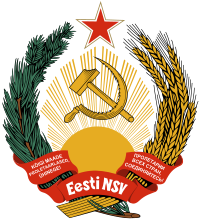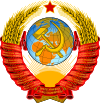
The hammer and sickle is a symbol meant to represent proletarian solidarity – a union between agricultural and industrial workers. It was first adopted during the Russian Revolution, the hammer representing workers and the sickle representing the farmers.

A red star, five-pointed and filled, is a symbol that has often historically been associated with communist ideology, particularly in combination with the hammer and sickle, but is also used as a purely socialist symbol in the 21st century. It has been widely used in flags, state emblems, monuments, ornaments, and logos.

The coat of arms of Estonia is a golden shield which includes a picture of three left-facing blue lions with red tongues in the middle, with golden oak branches placed on both sides of the shield. The insignia derive(s) from the coat of arms of Denmark, which ruled northern Estonia in the 13th-14th centuries and parts of western Estonia in the 16th-17th century.

The emblems of the constituent republics of the Union of Soviet Socialist Republics all featured predominantly the hammer and sickle and the red star that symbolised communism, as well as a rising sun, surrounded by a wreath of wheat. The USSR State motto, Workers of the world, unite!, in both the republic's language and Russian was also placed on each one of them. In addition to those repetitive motifs, emblems of many Soviet republics also included features that were characteristic of their local landscapes, economies or cultures.

Coat of arms of Republic of Latvia was officially adopted by the Constitutional Assembly of Latvia on July 15, 1921, and was in official use from August 19, 1921. It was created using new national symbols and elements of coats of arms of Polish and Swedish Livonia and of the Duchy of Courland and Semigallia. Thus the coat of arms combines symbols of Latvian national statehood, as well as symbols of its historical regions. The Latvian national coat of arms was designed by the Latvian artist Rihards Zariņš.

The national emblem of the Azerbaijan Soviet Socialist Republic was adopted in 1937 by the government of the Azerbaijan Soviet Socialist Republic. The style is based on the emblem of the Soviet Union.
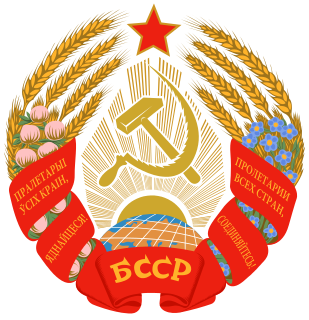
The Byelorussian SSR emblem was used as the coat of arms of the Soviet Socialist Republic until the fall of the Soviet Union. The coat of arms is based on the coat of arms of the Soviet Union.

The coat of arms of the Georgian Soviet Socialist Republic was adopted on May 20, 1921 by the government of the Georgian Soviet Socialist Republic. The coat of arms is loosely based on the coat of arms of the Soviet Union. It shows symbols of agriculture. The red star rising above the Caucasus stands for the future of the Georgian nation, and the hammer and sickle for the victory of Communism and the "world-wide socialist community of states".

The coat of arms of the Kazakh Soviet Socialist Republic was adopted on March 26, 1937, by the government of the Kazakh Soviet Socialist Republic. The coat of arms is based on the coat of arms of the Soviet Union.

The coat of arms of the Kirghiz Soviet Socialist Republic was adopted on March 23, 1937, by the government of the Kirghiz Soviet Socialist Republic. The coat of arms is based on the coat of arms of the Soviet Union. It shows symbols of agriculture on a backdrop of the Ala-Too mountain ranges, surrounded by a frame of folk art of the Kyrgyz people. The red star was added in 1948. The rising sun stands for the future of the Kyrgyz nation, the star as well as the hammer and sickle for the victory of communism and the "worldwide socialist community of states".
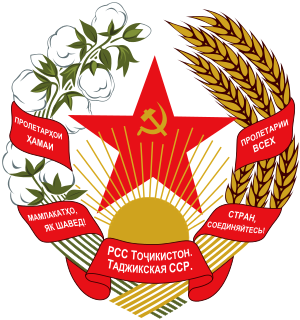
The State Emblem of the Tajik Soviet Socialist Republic was adopted on March 1, 1937 by the government of the Tajik Soviet Socialist Republic. The emblem is based on the State Emblem of the Soviet Union. It shows symbols of agriculture. The red star is prominently featured with a small hammer and sickle within it. The rising sun stands for the future of the Tajik nation, and the star as well as the hammer and sickle for the victory of communism and the "world-wide socialist community of states". The emblem was replaced with the new emblem in 1992, which uses a similar design to the Soviet one.

The Emblem of the Turkmen Soviet Socialist Republic was adopted on 2 March 1937 by the government of the Turkmen Soviet Socialist Republic. The coat of arms is based on the coat of arms of the Soviet Union. It shows symbols of agriculture and heavy industry, as well as a symbol of the Turkmen people, a rug. The rising Sun stands for the future of the Turkmen nation, the red star as well as the hammer and sickle for the victory of Communism and the "world-wide socialist community of states".

Emblem of the Latvian SSR was adopted on August 25, 1940, by the government of the Latvian SSR. It was based on the emblem of the Soviet Union. It features symbols of agriculture (wheat) and Latvia's maritime culture. The red star as well as the hammer and sickle for the victory of communism and the "world-wide socialist community of states".

The emblem of the Lithuanian Soviet Socialist Republic was adopted in 1940 by the government of the Lithuanian Soviet Socialist Republic. The emblem was designed by Vsevolodas Dobužinskis based on the State Emblem of the Soviet Union. The new coat of arms replaced the traditional coat of arms of Lithuania, known as Vytis, which was restored when Lithuania declared its independence in 1990.

The coat of arms of the Moldavian Soviet Socialist Republic was adopted on 10 February 1941 by the government of the Moldavian Soviet Socialist Republic. The coat of arms is based on the coat of arms of the Soviet Union. It shows symbols of agriculture, an outer rim featuring wheat, corn, grapes and clover. The red banner bears the Soviet Union state motto in both the Romanian language and the Russian language. In Romanian, it was initially "Пролетарь дин тоате цэриле, униць-вэ!"; then, from the 1950s "Пролетарь дин тоате цэриле, уници-вэ!". Both are written in the Latin alphabet as "Proletari din toate țările, uniți-vă!". The acronym MSSR is shown only in Romanian in Moldovan Cyrillic ("РССМ"). The emblem was replaced on 3 November 1990 by the present coat of arms of Moldova. Currently, the unrecognized breakaway state of Transnistria uses a similar state emblem.
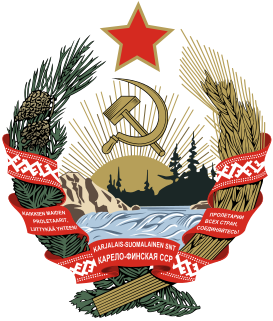
The emblem of the Karelo-Finnish Soviet Socialist Republic was adopted on February 10, 1941 by the government of the Karelo-Finnish Soviet Socialist Republic and used until it was absorbed into the Russian Soviet Federative Socialist Republic in 1956.

Coat of arms of Tallinn represents Tallinn, the capital city of Estonia.
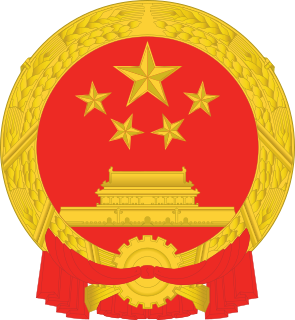
Socialist state emblems usually follow a unique style consisting of communist symbolism. Although commonly referred to as coats of arms, most are not actually traditional heraldic achievements. Many communist governments purposely diverged from heraldic tradition in order to distance themselves from the monarchies that they usually replaced, with coats of arms being seen as symbols of the monarchs.

The State Emblem of the Soviet Union was adopted in 1923 and was used until the dissolution of the USSR in 1991. Although it technically is an emblem rather than a coat of arms, since it does not follow traditional heraldic rules, in Russian it is called герб, the word used for a traditional coat of arms.

The Emblem of the Russian Soviet Federative Socialist Republic (RSFSR) was adopted on 10 July 1918 by the government of the Russian Soviet Federative Socialist Republic, and modified several times afterwards. It shows wheat as the symbol of agriculture, a rising sun for the future of the Russian nation, the red star as well as the hammer and sickle for the victory of Communism and the "world-wide socialist community of states".
